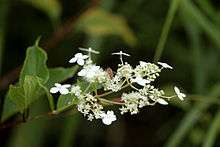Hydrangea
Hydrangea (/haɪˈdreɪndʒiə/;[1] common names hydrangea or hortensia) is a genus of 70–75 species of flowering plants native to Asia and the Americas. By far the greatest species diversity is in eastern Asia, notably Korea, China, and Japan. Most are shrubs 1 to 3 meters tall, but some are small trees, and others lianas reaching up to 30 m (98 ft) by climbing up trees. They can be either deciduous or evergreen, though the widely cultivated temperate species are all deciduous.[2]
| Hydrangea | |
|---|---|
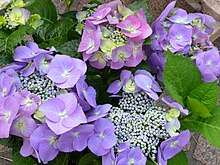 | |
| Hydrangea macrophylla | |
| Scientific classification | |
| Kingdom: | Plantae |
| Clade: | Tracheophytes |
| Clade: | Angiosperms |
| Clade: | Eudicots |
| Clade: | Asterids |
| Order: | Cornales |
| Family: | Hydrangeaceae |
| Genus: | Hydrangea L. |
| Species | |
|
See text | |
‘Hydrangea’ is derived from Greek and means ‘water vessel’, which is in reference to the shape of its seed capsules.[3] The earlier name, Hortensia, is a Latinised version of the French given name Hortense, referring to the wife of Jean-André Lepaute.[4]
Life cycle
Hydrangea flowers are produced from early spring to late autumn; they grow in flowerheads (corymbs or panicles) most often at the ends of the stems. Typically the flowerheads contain two types of flowers: small non-showy flowers in the center or interior of the flowerhead, and large, showy flowers with large colorful sepals (tepals). These showy flowers are often extended in a ring, or to the exterior of the small flowers. Plants in wild populations typically have few to none of the showy flowers, while cultivated hydrangeas have been bred and selected to have more of the larger type flowers.
There are two flower arrangements in hydrangeas with corymb style inflorescences, which includes the commonly grown "bigleaf hydrangea"—Hydrangea macrophylla. Mophead flowers are large round flowerheads resembling pom-poms or, as the name implies, the head of a mop. In contrast, lacecap flowers bear round, flat flowerheads with a center core of subdued, small flowers surrounded by outer rings of larger flowers having showy sepals or tepals. The flowers of some rhododendrons and viburnums can appear, at first glance, similar to those of some hydrangeas.
Hydrangea flowers, when cut, dehydrate easily and wilt very fast due to the large surface area of the petals. A wilted hydrangea may have its hydration restored by first having its stem immersed in boiling water; as the petals of the hydrangea can also absorb water, the petals may then be immersed, in room-temperature water, to restore the flower's hydration.[5]
Colours and soil acidity
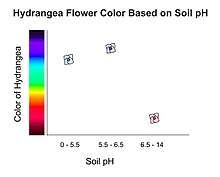
In most species the flowers are white, but in some species (notably H. macrophylla), can be blue, red, pink, light purple, or dark purple. In these species, floral color change occurs due to the presence of aluminium ions which are available or tied up depending upon the soil pH.[6][7] For H. macrophylla and H. serrata cultivars, the flower color can be determined by the relative acidity of the soil: an acidic soil (pH below 7), will have available aluminium ions and typically produce flowers that are blue to purple,[8] whereas an alkaline soil (pH above 7) will tie up aluminium ions and result in pink or red flowers. This is caused by a color change of the flower pigments in the presence of aluminium ions which can be taken up into hyperaccumulating plants.[9] Lowering the pH of potting soils or mixes usually does not change the flower color to blue, because these soils have no aluminium ions. The ability to blue or pink a hydrangea is also influenced by the cultivar. Some plants are selected for their ability to be blued, while others are bred and selected to be red, pink or white. The flower color of most other Hydrangea species is not affected by aluminium and cannot be changed or shifted. Hydrangeas are also nicknamed 'Change Rose'.
Partial list of species
- Hydrangea anomala (climbing hydrangea). Himalaya, southwest Mainland China.
- Hydrangea arborescens (smooth hydrangea). Eastern North America.
- Hydrangea aspera. Mainland China, Himalaya.
- Hydrangea bretschneideri. Mainland China.
- Hydrangea candida. Mainland China.
- Hydrangea caudatifolia. Mainland China.
- Hydrangea chinensis. Mainland China and Taiwan.
- Hydrangea chungii. Mainland China.
- Hydrangea cinerea (ashy hydrangea). Eastern United States.
- Hydrangea coacta. Mainland China.
- Hydrangea coenobialis. Mainland China.
- Hydrangea davidii. Mainland China.
- Hydrangea dumicola. Mainland China.
- Hydrangea gracilis. Mainland China.
- Hydrangea heteromalla. Himalaya, west and north Mainland China.
- Hydrangea hirta. Japan.
- Hydrangea hypoglauca. Mainland China.
- Hydrangea integrifolia. Mainland China.
- Hydrangea involucrata. Japan, Taiwan.
- Hydrangea jelskii. Andes.
- Hydrangea kawakamii. Taiwan.
- Hydrangea kwangsiensis. Mainland China.
- Hydrangea kwangtungensis. Mainland China.
- Hydrangea lingii. Mainland China.
- Hydrangea linkweiensis. Mainland China.
- Hydrangea longifolia. Mainland China.
- Hydrangea longipes. Western China.
- Hydrangea macrocarpa. Mainland China.
- Hydrangea macrophylla (bigleaf hydrangea). Southeast Japan, southern China.
- Hydrangea mangshanensis. Mainland China.
- Hydrangea paniculata (panicled hydrangea). Eastern Mainland China, Japan, Korea, Sakhalin.
- Hydrangea petiolaris (climbing hydrangea). Japan, Korea, Sakhalin.
- Hydrangea peruviana. Costa Rica and Panama, Andes.
- Hydrangea quercifolia (oakleaf hydrangea). Southeast United States.
- Hydrangea radiata (silverleaf hydrangea). Southeast United States.
- Hydrangea robusta. Mainland China, Himalaya.
- Hydrangea sargentiana. Western Mainland China.
- Hydrangea scandens. Southern Japan south to the Philippines.
- Hydrangea serrata. Japan, Korea.
- Hydrangea serratifolia. Chile, western Argentina.
- Hydrangea stenophylla. Mainland China.
- Hydrangea strigosa. Mainland China.
- Hydrangea stylosa. Mainland China.
- Hydrangea sungpanensis. Mainland China.
- Hydrangea tarapotensis. Andes.
- Hydrangea xanthoneura. Mainland China.
- Hydrangea zhewanensis. Mainland China.
Fossil record
†Hydrangea alaskana is a fossil species recovered from paleogene strata in Jaw Mountain Alaska.[10]
Four fossil seeds of †Hydrangea polonica have been extracted from borehole samples of the Middle Miocene fresh water deposits in Nowy Sacz Basin, West Carpathians, Poland.[11]
Cultivation and uses
Hydrangeas are popular ornamental plants, grown for their large flowerheads, with Hydrangea macrophylla being by far the most widely grown with over 600 named cultivars, many selected to have only large sterile flowers in the flowerheads. Hydrangea macrophylla, also known as Bigleaf Hydrangea, can be broken up into two main categories; Mophead Hydrangea & Lacecap Hydrangea.[12] Some are best pruned on an annual basis when the new leaf buds begin to appear. If not pruned regularly, the bush will become very 'leggy', growing upwards until the weight of the stems is greater than their strength, at which point the stems will sag down to the ground and possibly break. Other species only flower on 'old wood'. Thus new wood resulting from pruning will not produce flowers until the following season.
Hydrangea root and rhizome are indicated for treatment of conditions of the urinary tract in the PDR for Herbal Medicine and may have diuretic properties.[13] Hydrangeas are moderately toxic if eaten, with all parts of the plant containing cyanogenic glycosides.[14] Hydrangea paniculata is reportedly sometimes smoked as an intoxicant, despite the danger of illness and/or death due to the cyanide.[15][16]
The flowers on a hydrangea shrub can change from blue to pink or from pink to blue from one season to the next depending on the acidity level of the soil.[17] Adding organic materials such as coffee grounds, citrus peel or eggshells will increase acidity and turn hydrangea flowers blue, as described in an article on Gardenista.[18] A popular pink hydrangea called Vanilla Strawberry has been named "Top Plant" by the American Nursery and Landscape Association.
The hybrid "Runaway Bride Snow White", bred by Ushio Sakazaki from Japan, was named Plant of the Year at the 2018 RHS Chelsea Flower Show.[19]
In culture
In Japan, ama-cha,甘茶 meaning sweet tea, is another herbal tea made from Hydrangea serrata, whose leaves contain a substance that develops a sweet taste (phyllodulcin). For the fullest taste, fresh leaves are crumpled, steamed, and dried, yielding dark brown tea leaves. Ama-cha is mainly used for kan-butsu-e (the Buddha bathing ceremony) on April 8 every year—the day thought to be Buddha's birthday in Japan. During the ceremony, Ama-cha is poured over a statue of Buddha and served to people in attendance. A legend has it that on the day Buddha was born, nine dragons poured Amrita over him; ama-cha is substituted for Amrita in Japan.
In Korean tea, Hydrangea serrata (hangul:산수국 hanja:山水菊) is used for an herbal tea called sugukcha (수국차) or isulcha (이슬차).
The pink hydrangea has risen in popularity all over the world, especially in Asia. The given meaning of pink hydrangeas is popularly tied to the phrase, "You are the beat of my heart," as described by the celebrated Asian florist Tan Jun Yong, where he was quoted saying, "The light delicate blush of the petals reminds me of a beating heart, while the size could only match the heart of the sender!"[20]
Hydrangea quercifolia was declared the official state wildflower of Alabama in 1999.[21]
Gallery
 Hydrangea flowers close up.
Hydrangea flowers close up. Flowers
Flowers Hydrangea macrophylla, flowers.
Hydrangea macrophylla, flowers.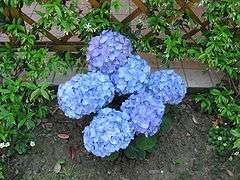 Hydrangea macrophylla, flowers
Hydrangea macrophylla, flowers- Hydrangea sp painted by the botanical artist Redouté.
 Hydrangea quercifolia
Hydrangea quercifolia Hydrangea macrophylla, leaves
Hydrangea macrophylla, leaves Wild Hydrangea v. Annabelle
Wild Hydrangea v. Annabelle
Hydrangea arborescens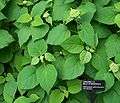 Wild Hydrangea v. Annabelle
Wild Hydrangea v. Annabelle
Hydrangea arborescens- 8" Annabelle Hydrangea Bloom. Hydrangea arborescens.
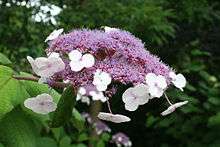 Hydrangea aspera ssp. sargentiana
Hydrangea aspera ssp. sargentiana- Hydrangea flowers from Kerala, India
- Hydrangeas in front of the Office de Tourisme Building in Chartres, France.
- Hydrangea flowers at the "Cerro El Avila" National Park, Venezuela.
 Hydrangea flowers, Srinagar, Kashmir, India.
Hydrangea flowers, Srinagar, Kashmir, India. Hydrangea flowers
Hydrangea flowers Hydrangea flowers in Petrópolis, Brazil.
Hydrangea flowers in Petrópolis, Brazil. Hydrangeas near the Black Lake of Gramado, southern Brazil.
Hydrangeas near the Black Lake of Gramado, southern Brazil. Purple hydrangea flowers
Purple hydrangea flowers Hydrangea arborescens leaf
Hydrangea arborescens leaf


Diseases
Notes
- Sunset Western Garden Book, 1995:606–607
- "The United States National Arboretum: Hydrangea FAQ". Archived from the original on 2013-05-16. Retrieved 2008-11-27.
- Gledhill, David (2008). "The Names of Plants". Cambridge University Press. ISBN 9780521866453 (hardback), ISBN 9780521685535 (paperback). pp 50, 206
- "hortensia | Definition of hortensia in English by Oxford Dictionaries". Oxford Dictionaries | English. Retrieved 2017-12-07.
- Kyle (2018-09-13). "Scentales | Florist Best Kept Secret: How to Save Wilting Hydrangeas". Scentales Florist. Retrieved 2019-11-25.
- "Publications - UGA Cooperative Extension". www.caes.uga.edu. Retrieved 31 May 2018.
- "USDA: Hydrangea Questions and Answers". Archived from the original on 16 May 2013. Retrieved 31 May 2018.
- "Hydrangea". Encyclopædia Britannica 1911. Retrieved 2014-01-17..
- "Hydrangea Plants".
- Hollick, Arthur (1925). "A New Fossil Species of Hydrangea". Bulletin of the Torrey Botanical Club. 52 (1): 21–22. JSTOR 2479996.
- Łańcucka-Środoniowa M.: Macroscopic plant remains from the freshwater Miocene of the Nowy Sącz Basin (West Carpathians, Poland) [Szczątki makroskopowe roślin z miocenu słodkowodnego Kotliny Sądeckiej (Karpaty Zachodnie, Polska)]. Acta Palaeobotanica 1979 20 (1): 3-117.
- "The Complete Guide to All Hydrangea Types | Plant Addicts". plantaddicts.com. Retrieved 2017-11-20.
- PDR for Herbal Medicine 3rd Edition Page 453
- "Hills of Snow". Retrieved 31 May 2018.
- "Erowid Hydrangea Vault". www.erowid.org. Retrieved 31 May 2018.
- Willsher, Kim (6 February 2014). "High danger hydrangea? French police hunt gang peddling 'cheaper weed'". the Guardian. Retrieved 31 May 2018.
- "Everything You Need to Know About Hydrangeas". www.gardenista.com. 2018-06-10. Retrieved 15 June 2018.
- "Hydrangeas: How To Change Color from Pink to Blue". www.gardenista.com. 2016-05-10. Retrieved 15 June 2018.
- "This plant has been named 'plant of the year' at the Chelsea Flower Show". 2018-05-22. Retrieved 31 May 2018.
- "Hydrangeas, Hydrangeas, Hydrangeas - Roll Gardening & Green :: Roll Magazine: Creative Living in the Hudson Valley". www.rollmagazine.com. Retrieved 31 May 2018.
- State Botanical SymbolsBy Alan McPherson, p.3
References

External links
| Wikimedia Commons has media related to Hydrangea. |
